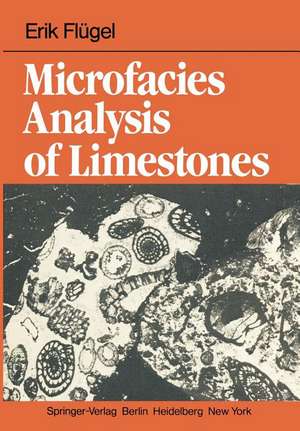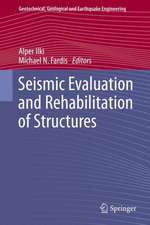Microfacies Analysis of Limestones
Autor E. Flügel Traducere de K. Christensonen Limba Engleză Paperback – 7 dec 2011
Preț: 662.16 lei
Preț vechi: 779.02 lei
-15% Nou
Puncte Express: 993
Preț estimativ în valută:
126.72€ • 130.91$ • 105.46£
126.72€ • 130.91$ • 105.46£
Carte tipărită la comandă
Livrare economică 26 martie-09 aprilie
Preluare comenzi: 021 569.72.76
Specificații
ISBN-13: 9783642684258
ISBN-10: 3642684254
Pagini: 652
Ilustrații: XIV, 634 p.
Dimensiuni: 170 x 244 x 34 mm
Greutate: 1.02 kg
Ediția:Softcover reprint of the original 1st ed. 1982
Editura: Springer Berlin, Heidelberg
Colecția Springer
Locul publicării:Berlin, Heidelberg, Germany
ISBN-10: 3642684254
Pagini: 652
Ilustrații: XIV, 634 p.
Dimensiuni: 170 x 244 x 34 mm
Greutate: 1.02 kg
Ediția:Softcover reprint of the original 1st ed. 1982
Editura: Springer Berlin, Heidelberg
Colecția Springer
Locul publicării:Berlin, Heidelberg, Germany
Public țintă
ResearchCuprins
1 Introduction to Fades Analysis.- 1.1 The Microfacies Concept.- 1.2 Methods of Facies Analysis.- 1.3 References.- 1.4 Supplementary Reading.- 2 Recent Carbonate Sedimentation.- 2.1 Carbonate Mineralogy.- 2.2 Carbonate Sedimentation in Marine Environments.- 2.3 Lacustrine and Terrestrial Carbonate Sedimentation.- 2.4 References: Recent Carbonate Sedimentation.- 3 Carbonate Diagenesis.- 3.1 Diagenetic Environments. Classification of Diagenetic Processes.- 3.2 Carbonate Destruction.- 3.3 Cementation.- 3.4 Sparite and Microsparite Terminology.- 3.5 Lithification of Lime Mud.- 3.6 Compaction.- 3.7 Stylolites.- 3.8 Calcite Veins.- 3.9 References: Carbonate Diagenesis.- 4 Microfacies Characteristics.- 4.1 “Groundmass” and Particles.- 4.2 Textural and Structural Criteria.- 4.3 Frequency Analysis (Constituent Analysis).- 5 Fossils in Thin-Sections.- 5.1 General Survey.- 5.2 Key to Identification.- 5.3 Selected Groups of Organisms.- 5.4 Microfacies Zones (with References).- 5.5 Annotated Bibliography: Microfacies Monographs.- 6 Classifications of Carbonate Rocks.- 6.1 Principles of Classification.- 6.2 Systems of Classification.- 6.3 Discussion and Examples.- 6.4 References: Classification of Carbonate Rocks.- 7 Microfacies Types.- 7.1 Prerequisites.- 7.2 Qualitative Categorization.- 7.3 Quantitative Categorization.- 7.4 Checklist for Microfacies Studies.- 8 Standard Microfacies Types.- 8.1 Principles.- 8.2 SMF Types.- 8.3 SMF Types and Facies Belts.- 8.4 Discussion and Examples.- 8.5 References: Standard Microfacies Types.- 9 Complementary Methods.- 9.1 Relationship Between Microfacies and Geochemical Criteria.- 9.2 Relationship Between Microfacies and Physical Criteria.- 9.3 Relationship Between Microfacies and Chemism of Carbonate Rocks.- 9.4 References: Physical andTechnological Criteria of Limestones.- 10 Facies Diagnosis and Facies Models.- 10.1 Diagnosis of Environmental Factors.- 10.2 Facies Criteria.- 10.3 Facies Models.- 11 Case Histories.- 11.1 Lacustrine Carbonates: Miocene Lake Deposits of the Ries, Southern Germany.- 11.2 Arid Carbonate Shorelines and Evaporites: Miocene of the Gulf of Suez Region, Egypt.- 11.3 Inner Shelf Carbonate Platform: Upper Jurassic of Karaburun, Western Anatolia.- 11.4 Outer Shelf Carbonate Platform: Upper Jurassic Sulzfluh Limestone, Graubünden, Switzerland.- 11.5 Ecologic Reefs: Upper Triassic Dachstein Reef Limestones of the Northern Alps, Austria.- 11.6 Stratigraphie Reefs: Lower Permian Trogkofel Limestones of the Southern Alps.- 11.7 Mud Mounds: Sponge-Algal Buildups from the Upper Jurassic of Northern Franconia, Germany.- 11.8 Subtidal Open-Marine Shelf Carbonates: Mishrif Formation, Cretaceous, Middle East.- 11.9 Shallow-Water Limestone Turbidites: Allodapic Limestones in the Upper Jurassic of Southern Franconia, Germany.- 11.10 Allochthonous Carbonate Deposits: Liassic Scheck Conglomerate: Adnet, Salzburg/Austria.- 12 Answers to Exercises.- 13 Indices.- 13.1 Author Index.- 13.2 Subject Index.- 13.3 Where to Find the Plates.












